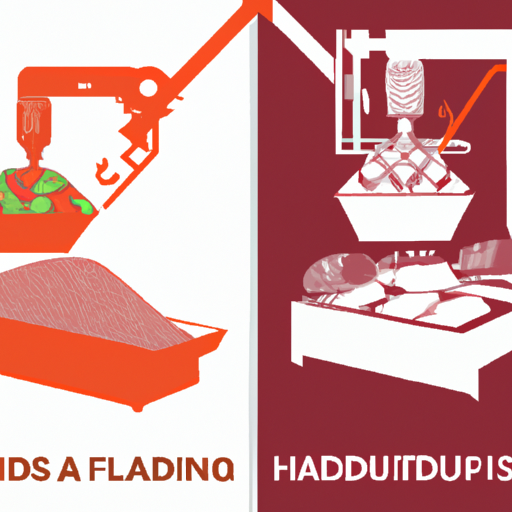Product Market Fit Analysis
So you’ve developed a brilliant product, but how do you know if it will truly resonate with your target market? That’s where a product market fit analysis comes in. In this article, we’ll explore why analyzing the fit between your product and the market is crucial for success, and how you can conduct an effective analysis to ensure your product is positioned for maximum impact. Get ready to uncover the insights that will set your product apart and pave the way for its success in the marketplace.

Table of Contents
Introduction
In the competitive business landscape, it is crucial for companies to understand the concept of product-market fit analysis. This article will provide a comprehensive overview of what product-market fit analysis is, its importance, and its purpose. Additionally, it will explore methods to determine product-market fit, measures to gauge it, the importance of conducting product-market fit analysis, challenges in achieving it, methods to improve it, and case studies of both successful and failed product-market fit.
What is Product Market Fit Analysis
Definition
Product-market fit analysis refers to the process of evaluating the fit between a product and its target market. It involves understanding the needs and preferences of the customers and ensuring that the product meets those needs. Product-market fit analysis helps businesses determine if their product is capable of satisfying the demands of the market and if there is a strong match between the product and its intended audience.
Importance
Product-market fit analysis is crucial for the success of any business. It helps companies identify the viability of their product in the market and whether or not it has the potential for success. By analyzing the fit between the product and the market, businesses can make informed decisions about their product development, marketing strategies, and overall business direction.
Purpose
The purpose of product-market fit analysis is to assess whether a product meets the needs and expectations of the target market. It helps businesses determine if their product is solving a real problem for the customers and if there is a demand for it. Additionally, the analysis allows companies to identify potential gaps in their product and make improvements to enhance its fit with the market.
How to Determine Product Market Fit
Define Customer Segment
To determine product-market fit, it is essential to define the target customer segment. This involves identifying the specific group of customers who are most likely to benefit from the product and are willing to pay for it. By understanding the characteristics, preferences, and behaviors of the target customer segment, companies can tailor their product and marketing efforts to better cater to their needs.
Identify Customer Needs
Another crucial step in determining product-market fit is identifying customer needs. This involves conducting comprehensive research to understand what problems or challenges the customers are facing and how the product can address those needs effectively. By identifying and addressing customer needs, businesses can ensure that their product is solving a real problem and providing value to the customers.
Conduct Market Research
market research plays a significant role in determining product-market fit. Through market research, businesses can gather insights about the target market, including customer preferences, competitors’ offerings, market trends, and potential demand for the product. This allows companies to make informed decisions about product positioning, pricing, and marketing strategies.
Test Minimum Viable Product
To determine product-market fit, it is crucial to test the product in the market. One effective approach is to develop a minimum viable product (MVP) and test it with the target customers. The MVP is a simplified version of the product that allows companies to gather feedback and insights about its functionality, usability, and appeal. Testing the MVP enables businesses to make necessary adjustments and improvements to meet the needs of the customers.
Collect and Analyze Feedback
Collecting and analyzing customer feedback is essential to determine product-market fit. This can be done through surveys, interviews, focus groups, or online reviews. By listening to the customers’ opinions and experiences, companies can gain valuable insights into the strengths and weaknesses of the product. Analyzing this feedback helps businesses identify areas of improvement, refine their product, and align it with the expectations of the target market.
Signs of Product Market Fit
Rapid Growth
One of the key signs of product-market fit is rapid growth. When a product successfully meets the needs of the target market, it attracts a large number of customers, resulting in exponential growth. Rapid growth indicates that the product is resonating with the customers and that there is a strong demand for it in the market.
Positive Customer Feedback
Positive customer feedback is another significant indicator of product-market fit. When customers express their satisfaction and appreciation for a product, it suggests that the product is meeting their expectations and providing value. Positive feedback can be in the form of reviews, testimonials, or word-of-mouth recommendations, and it serves as social proof for potential customers.
High Retention Rate
A high retention rate is an important sign of product-market fit. When customers continue to use a product over an extended period and become repeat customers, it indicates that the product is meeting their needs effectively. High retention rates indicate customer satisfaction, loyalty, and the product’s ability to fulfill its intended purpose.
Low Customer Acquisition Cost
A low customer acquisition cost is another indication of product-market fit. When the cost of acquiring new customers is low, it suggests that the product has resonated with the target market and customers are actively seeking it out. A low customer acquisition cost signifies that the product has strong market demand, leading to increased profitability and sustainable growth.

Measuring Product Market Fit
Net Promoter Score (NPS)
The Net Promoter Score (NPS) is a widely used metric to measure product-market fit. It measures customer loyalty and satisfaction by asking customers a simple question: “On a scale of 0 to 10, how likely are you to recommend this product to a friend or colleague?”. Based on their responses, customers are categorized into three groups: Promoters (score 9-10), Passives (score 7-8), and Detractors (score 0-6). The NPS is calculated by subtracting the percentage of detractors from the percentage of promoters. A high NPS indicates strong product-market fit.
Customer Acquisition Cost (CAC)
Customer Acquisition Cost (CAC) is a measure of how much it costs a company to acquire a new customer. It includes the costs associated with marketing, advertising, sales, and other activities aimed at attracting customers. By comparing the CAC to the revenue generated from each customer, companies can assess the efficiency of their acquisition strategies. A low CAC indicates effective product-market fit, as it suggests that the cost of acquiring customers is relatively small compared to the generated revenue.
Customer Lifetime Value (CLTV)
Customer Lifetime Value (CLTV) measures the total value that a customer brings to a business throughout their relationship. It takes into account the revenue generated from the customer, the cost of serving them, and the duration of the customer’s relationship with the company. A high CLTV indicates strong product-market fit, as it suggests that customers find value in the product and continue to generate revenue for the company over an extended period.
Churn Rate
Churn rate measures the rate at which customers discontinue using or purchasing a product or service. A high churn rate indicates poor product-market fit, as it suggests that customers are not finding value in the product and are seeking alternatives. By tracking the churn rate, companies can identify areas of improvement and make necessary adjustments to retain customers and improve product-market fit.
Importance of Product Market Fit Analysis
Reduced Risk of Failure
Product-market fit analysis reduces the risk of product failure. By thoroughly evaluating the fit between the product and the market, companies can identify potential issues and make necessary adjustments early on in the product development process. This reduces the likelihood of launching a product that does not meet the needs of the customers, saving time, resources, and potential reputational damage.
Increased Revenue and Profits
Achieving product-market fit is directly linked to increased revenue and profits. When a product successfully meets the needs of the target market, it attracts a larger customer base, leading to increased sales and revenue. Additionally, satisfied customers are more likely to become repeat customers and recommend the product to others, resulting in sustained growth and profitability.
Strong Customer Relationships
Product-market fit analysis helps businesses build strong customer relationships. By understanding and addressing customer needs, companies can create products and experiences that resonate with the customers. This leads to increased customer satisfaction, loyalty, and trust, fostering long-term relationships and customer advocacy.
Competitive Advantage
Product-market fit analysis provides a competitive advantage. By thoroughly understanding the needs and preferences of the target market, companies can differentiate their product from competitors’ offerings. By continuously monitoring and improving product-market fit, businesses can stay ahead of the competition and gain a higher market share.
Challenges in Achieving Product Market Fit
Understanding Customer Needs
One of the main challenges in achieving product-market fit is understanding customer needs accurately. Customers may have unexpressed or evolving needs, making it essential to conduct in-depth research and gather insights. Failure to understand customer needs can result in developing a product that fails to provide the desired value and does not meet the expectations of the target market.
Effective Market Research
Conducting effective market research is another challenge in achieving product-market fit. It requires gathering reliable data, analyzing market trends, and understanding customer behavior. Insufficient or inaccurate market research can lead to misalignment between the product and the market and hinder the achievement of product-market fit.
Iterative Product Development
Iterative product development is essential in achieving product-market fit. It involves continuously refining and improving the product based on customer feedback and market insights. However, this iterative process can be challenging, as it requires flexibility, agility, and willingness to make necessary changes. Lack of iterative product development can result in a product that fails to evolve with changing market needs and preferences.
Competitor Analysis
Conducting competitor analysis is crucial in achieving product-market fit. By understanding competitors’ offerings, strengths, and weaknesses, companies can differentiate their product and position it effectively in the market. However, identifying and analyzing competitors can be challenging, particularly in highly competitive industries where new players continually enter the market.
Methods to Improve Product Market Fit
Continuous Customer Feedback
Continuous customer feedback is crucial for improving product-market fit. By regularly gathering feedback, companies can identify areas of improvement, address customer concerns, and adapt the product to better meet customer needs. This can be done through surveys, focus groups, customer interviews, social media monitoring, and online reviews.
Iterative Product Development
Iterative product development is a method to improve product-market fit. By developing a minimum viable product and testing it with the target customers, companies can gather feedback and make necessary adjustments. This iterative approach allows for continuous improvement and ensures that the product evolves to meet the changing needs of the market.
Segmentation and Targeting
Segmentation and targeting involve identifying specific customer segments and tailoring the product and marketing efforts to cater to their needs. By understanding the unique characteristics, preferences, and expectations of different customer segments, companies can customize their offering and enhance product-market fit.
Competitive Analysis
Competitive analysis is a method to improve product-market fit. By analyzing competitors’ offerings, companies can identify gaps in the market that their product can fill. Additionally, by monitoring competitors’ actions and strategies, businesses can proactively respond to market dynamics, differentiate their product, and achieve a stronger fit with the target market.
Case Studies: Successful Product Market Fit
Case Study 1: Apple iPhone
The Apple iPhone is a prime example of successful product-market fit. Apple identified a gap in the market for a smartphone that combined functionality, design, and simplicity. By understanding customer needs and preferences, Apple developed the iPhone, which revolutionized the mobile industry. The seamless integration of hardware, software, and services, along with a user-friendly interface, led to rapid growth, positive customer feedback, and high customer retention rates.
Case Study 2: Airbnb
Airbnb is another successful example of product-market fit. Airbnb identified the need for affordable and unique accommodations, offering travelers an alternative to traditional hotels. By connecting homeowners with travelers, Airbnb created a platform that fulfilled the needs of both hosts and guests. The platform’s rapid growth, positive customer feedback, and low customer acquisition costs indicate a strong product-market fit.
Case Study 3: Netflix
Netflix is a compelling example of successful product-market fit. Recognizing the shift in consumer behavior towards streaming entertainment, Netflix revolutionized the way people consume movies and TV shows. By providing a vast library of content, personalized recommendations, and the convenience of on-demand viewing, Netflix met the needs of customers who craved entertainment at their fingertips. Their rapid growth, high retention rates, and widespread customer satisfaction demonstrate a strong product-market fit.
Case Studies: Failed Product Market Fit
Case Study 1: Microsoft Zune
The Microsoft Zune is a notable example of failed product-market fit. Microsoft launched the Zune as a competitor to the Apple iPod but failed to gain significant market share. Despite having comparable features to the iPod, the Zune struggled to resonate with customers and failed to provide a unique value proposition. The lack of positive customer feedback, low customer retention rates, and high customer acquisition costs indicated a weak product-market fit.
Case Study 2: Google Glass
Google Glass is an example of a product that failed to achieve product-market fit. Google introduced the wearable technology as a groundbreaking device with augmented reality capabilities. However, it failed to gain widespread consumer acceptance due to privacy concerns, high price point, and limited functionality. The lack of rapid growth, negative customer feedback, and low adoption rates contributed to its failure in achieving strong product-market fit.
Case Study 3: Juicero
Juicero is a cautionary example of a product that lacked product-market fit. Juicero developed a high-priced juicing machine capable of squeezing juice from pre-packaged fruit and vegetable pouches. However, the product faced criticism for its high cost, limited utility, and the availability of alternative, less expensive juicing options. The lack of positive customer feedback, low customer retention rates, and unfavorable market response demonstrated the failure to achieve strong product-market fit.
Conclusion
Product-market fit analysis is essential for businesses to determine the viability and success of their product in the market. By understanding the needs and preferences of the target market, conducting thorough market research, and continuously gathering and analyzing customer feedback, companies can improve product-market fit and achieve rapid growth, customer satisfaction, and increased profitability. While challenges may arise in understanding customer needs, conducting effective market research, implementing iterative product development, and analyzing competitors, adopting methods to improve product-market fit, such as continuous customer feedback, segmentation and targeting, and competitive analysis, can aid in achieving success. By studying case studies of both successful and failed product-market fit, businesses can gain valuable insights and learn from past experiences. Ultimately, product-market fit analysis plays a critical role in reducing the risk of failure, increasing revenue and profits, fostering strong customer relationships, and creating a competitive advantage in the marketplace.






